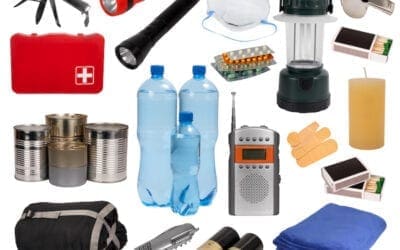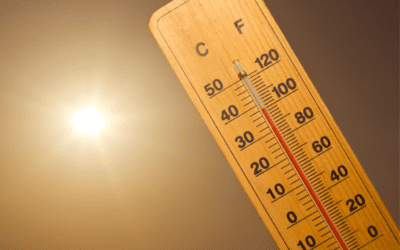Extreme Cold Preparedness Tips

Winters in Missouri can be unpredictable and almost always have periods of extreme cold weather. Even short periods of exposure to extreme cold temperatures can lead to frostbite or hypothermia. Extreme temperatures can be life-threatening if you or your family are not ready with extreme cold preparedness tips. It’s especially important to prepare those who are at a higher risk, such as older adults, young children, and those who are sick.
To make extreme cold temperatures worse, Missouri is prone to strong winds that can cause cold temperatures to drop even lower. High winds increase the wind chill during cold temperatures, causing the temperature to “feel like” it is even colder. This is because the cold wind strips away the thin layer of warm air above your skin, making frostbite and hypothermia more of a concern.
Be prepared before extreme cold temperature hits by following the preparedness tips below:
- Monitor weather channels to hear up-to-date forecasts
- Prepared your home and vehicle:
- Make sure your vehicle has a full gas tank
- Make sure your tires are in good condition
- Check your antifreeze levels, battery life, defroster, windshield wipers and fluid levels
- Create an emergency car kit
- Ensure heating equipment is well maintained and chimneys are cleared and inspected
- Check that smoke and carbon monoxide detectors are functioning and have fresh batteries
If a winter storm brings extreme cold temperatures:
- Minimize outdoor activity.
- Keep pets indoors – they get cold too! If it is too cold for you outside, it is too cold for them.
- If you must be outdoors, dress in multiple layers and wear a hat, mittens (not gloves) and waterproof boots to protect extremities. Do not dress in one, large layer.
- Base layer: wear moisture wicking material to remove perspiration from your skin. The most effective materials for this are polypropylene, polyester, silk, or merino wool.
- Mid layer: Mid layers should be loose and insulating for trapping body heat. Mid layers should be made out of fabrics such as nylon, non-bulky fleece, or merino wool.
- Outer layer: wearing an outer shell is important to protect you from cold, penetrating winds. Outer layers should be close against your body and tightly woven to resist wind and water.
- Cover your mouth with a scarf to protect your lungs.
- Be prepared with a fire extinguisher handy if you are using space heaters, a fire place, or a wood stove.
- DO NOT run generators indoors. Make sure they are well ventilated and outdoors.
- If the power goes out, head to a warming center until power can be restored.
- Check on elderly neighbors, family, and friends, as they may additional assistance.
Pay attention to your body. If you start to shiver and it doesn’t stop, it’s time to go inside!
Cold-Related Illnesses
Extreme cold has the potential to cause cold related illnesses or injuries such as frostbite or hypothermia. It is important to know the signs and symptoms and what actions to take if you think yourself or a loved one has been affected.
Frostbite is the freezing of the skin or body tissue.
Symptoms of frostbite include:
- Loss of feeling in the affected area
- White or pale appearance of skin or in extremities such as fingers, toes, earlobes, and the tip of the nose.
To treat frostbite:
- Get the victim to a warm area immediately.
- Seek medical attention immediately.
- Cover all exposed skin and do not rub the affected area in an attempt to warm it up.
Hypothermia is a life-threatening, abnormally low body temperature which can be caused by excessive exposure to extreme cold temperatures.
Symptoms of hypothermia include:
- Shivering
- Exhaustion
- Confusion
- Memory loss
- Slurred speech
If hypothermia is a concern, take the person’s temperature. If their temperature is below 95 degrees, seek medical attention immediately. Move the individual to a warm area, remove all wet clothing, and begin by warming the center of the body first by wrapping them in blankets or putting on dry clothing. Give them warm, non-alcoholic beverages if they are conscious while you wait for medical help to arrive.
To learn more about hypothermia, visit https://www.mayoclinic.org/diseases-conditions/hypothermia/symptoms-causes/syc-20352682
Archives
- December 2025 (1)
- November 2025 (2)
- September 2025 (1)
- July 2025 (2)
- June 2025 (3)
- April 2025 (2)
- February 2025 (1)
- January 2025 (2)
- December 2024 (1)
- September 2024 (2)
- August 2024 (2)
- July 2024 (1)
- June 2024 (1)
- February 2024 (1)
- July 2023 (1)
- March 2023 (1)
- October 2022 (1)
- September 2022 (1)
- August 2022 (1)
- July 2022 (2)
- June 2022 (2)
- May 2022 (1)
- April 2022 (4)
- March 2022 (1)
- February 2022 (1)
- January 2022 (1)
- December 2021 (4)
- November 2021 (3)
- September 2021 (2)
- August 2021 (3)
- July 2021 (2)
- June 2021 (1)
- May 2021 (2)
- March 2021 (1)
- December 2020 (6)
- November 2020 (8)
- October 2020 (4)
- September 2020 (7)
- August 2020 (3)
- July 2020 (11)
- May 2020 (2)
- April 2020 (4)
- March 2020 (1)
Categories
- Communicable Disease (5)
- Clinical Services (19)
- Clinical Servcies (1)
- Health Promotions (74)
- Emergency Preparedness (8)





